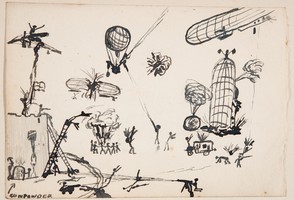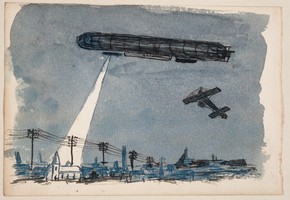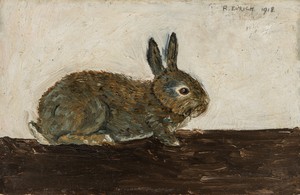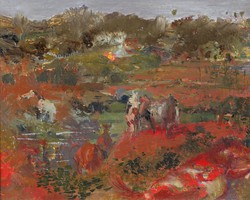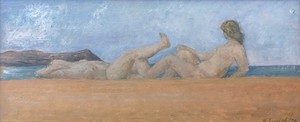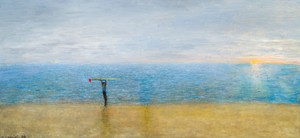1903
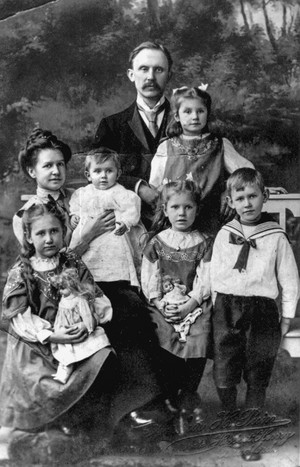
Dr and Mrs Eurich with their five children (Richard in the sailor suit). Christmas, 1910
Image © Richard Eurich Paintings
Born in Bradford, Yorkshire, 14 March 1903, the second of five children, his German born father, Dr FW Eurich, a GP and bacteriologist at Bradford Council's Pathological and Bacteriological Laboratory, his mother a Yorkshire Quaker.
Lived at 7 Lindum Terrace, Manningham Lane, Bradford.
1905
Richard's father appointed as bacteriologist to The Bradford Anthrax Investigation Board, a sideline to his growing consutling practice. The board were trying to find ways to eliminate anthrax, the cause of countless deaths among wool sorters.
c1905
Father always welcomed us when we visited him in his laboratory and answered any questions about what he was doing or about any apparatus with pleasure.
. . . He had incubators in which he developed cultures of Anthrax, spending fifteen years working on samples of wool from all parts of the world. He hoped to be able to eliminate the infection and at the same time tried to find a means of disinfecting wool already imbued with the deadly germ . . .
1908
Richard's father appointed Professor of Forensic Medicine at Leeds Medical School.
September 1908
At five, being of school age, I joined my elder sister at the Kindergarten [at Rossfield School].
It may seem strange to relate that all I ever learned at school was taught me here. Four years at the boarding school was scholastically barren and of the two years at Bradford Grammar School, the second year only was fruitful in that I learned to like Shakespeare.
December 1908
Moved to 4 Marlborough Road, Manningham, Bradford.
1910
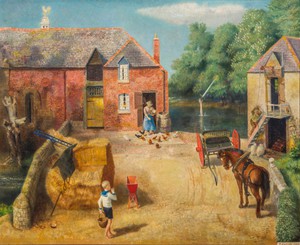
Image © Richard Eurich Paintings
When Richard was 7 he stayed with a great uncle. He was sent to a local farm for eggs and had a mystical experience there, the inspiration for his 1947 painting 'Remembrance of Things Past'.
August 1910
Moved to 8 Mornington Villas, Manningham, Bradford, the house with the steps that occur in some works such as the two "Mummers" paintings: The Mummers (1951), The Mummers (1952)
[unknown date]
Father's mother had evidently become aware before anyone else that pictures meant something to me. One Christmas she sent me a picture. I thought there must be some mistake because children were not given pictures in frames. It was by the German painter, Defregger, of a group of children bringing a sick dog to a doctor's house. I liked it very much.
1911

The Queen of the Sea,1911 painted in 1954. Richard brings to life the memory of that holiday in Whitby with hallucinatory clarity
Image © Royal Academy of Arts
Visited Whitby in the summer of coronation year, an event remembered in his painting 'Whitby, Queen of the Sea, 1911' (1954).
1912
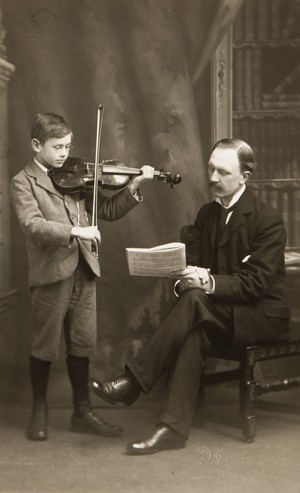
Richard and his father posed for a photograph in about 1913
Image © Richard Eurich Paintings
Richard started to have violin lessons.
So at the age of nine I was inspected by a lady violin teacher who examined my hands and said I would do. A three-quarter-size violin was procured and a start was made.
Photo: Richard playing the violin with his father holding the music.
Richard visited his grandmother in Saxony, Germany
. . . my memories of that time are chiefly of unending marching of soldiers with military bands.
Moved to 8 Mornington Villas
[The house] hadn't any gas. For a moment we were amazed and then Father, having had his little surprise, explained that it was lit by electricity.
